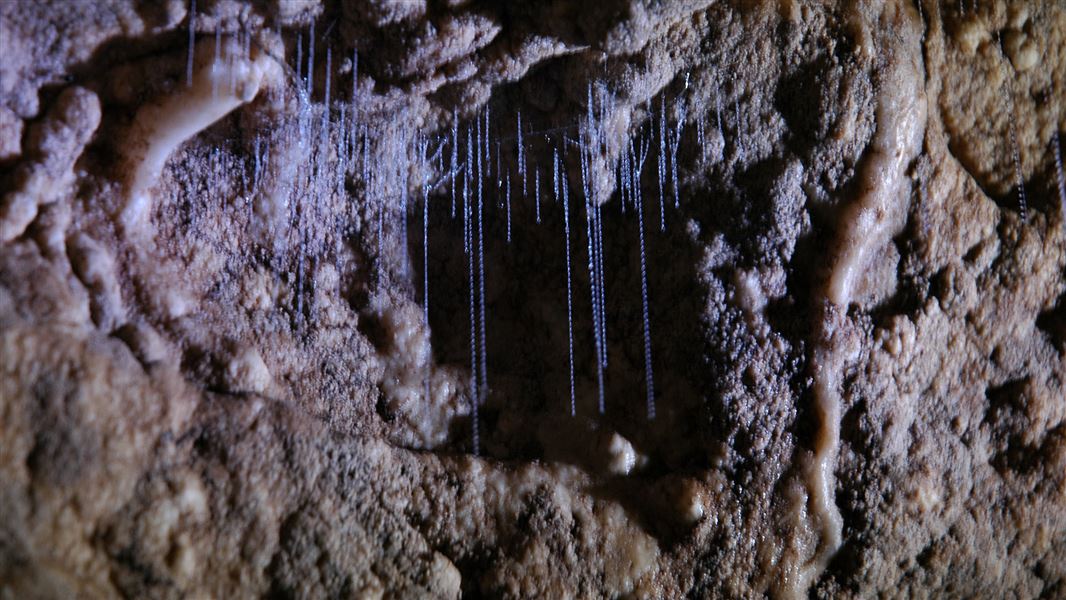View the stalactites and glow worms within the rare Clifden cave system.
The Clifden Suspension Bridge was an important transport link in what was a relatively remote part of Southland.
Image gallery
Travel on SH96 to approximately 1 km north-east of the Clifden/ Blackmount corner on Clifden Gorge Road. There is a signpost opposite the car park indicating the cave entrance. Access to the caves is over the stile, and though private property, so respect the area.
Clifden Suspension Bridge is also located on SH99, 16 km north of Tuatapere.
- Warning: This cave system is subject to flash flooding. Do not enter during or immediately after heavy rain.Take two torches per person and spare batteries. Both a head torch and a hand held torch are recommended.
- We recommend you keep party sizes small. At least two people is recommended for safety reasons but no more than six for minimum environmental impact.
- Always leave your trip intentions (return time, planned route, party numbers etc) with a reliable person. Remember to check in on returning.
- Wear sensible clothing and sturdy footwear as you are likely to get wet and muddy. The caves are often wet and the air temperature will be colder than outside. Wear clothes that are warm, even when wet, e.g. polypropylene or wool. Cotton clothing is not suitable.
- Beware of unstable rocks and low ceilings. Wearing a helmet is recommended.
- There are unmarked corridors in the cave system. These are only suitable for experienced and well equipped caving parties. Ropes and climbing equipment are required.
- Take care when travelling through the caves as the flooring of the caves are rough underfoot with loose rocks and stones. Surfaces are often slippery.
- The caves are suitable for fit and agile adults and children aged 12 and older.
Leave the land undisturbed – toitu to whenua. Minimise your impact by leaving as little trace of your visit as possible. Carry it in, carry it out. Take all your rubbish with you.
Limestone caves
Limestone caves are the most common type of cave in New Zealand and the world. Limestones are rocks containing high levels of calcium carbonate. The limestone at Clifden formed in the early Miocene time (c. 22-18 million years ago) from the accumulation of shell fragments, sand and pebbles in a shallow sea. This sediment was buried and compressed beneath further layers of sediment and later folded, uplifted and eroded to form the present land surface.
Limestone caves form over a long period of time when acidic groundwater seeps through cracks in the rock and dissolves the calcium carbonate in the surrounding limestone.This creates passageways and unusual formations such as stalactites and stalagmites that gradually become larger and form cave systems.
Stalactites and stalagmites
Stalactites are the spikes hanging from the roof of a limestone cave, and stalagmites are the spires projecting upwards from the floor of the cave. Both form as a result of the precipitation of calcium carbonate continually dripping water from the cave roof over periods of hundreds and thousands of years.
The Clifden Caves feature some spectacular formations on the ceilings and walls. Refrain from touching cave formations as they have taken millions of years to form and are very fragile.
Glow worms/titiwai
Glow worms/titiwai (Arachnocampa luminosa) are a feature of some cave systems. New Zealand glow worms are the larvae of small flies called fungus gnats which undergo a four stage life cycle: egg, larvae, pupae and adult fly. Only the larvae can feed and produce light. This ‘glow’ is used to attract prey which is caught in sticky silk threads that hang from the glow worm nest. These silk fishing lines are then hauled in and the captured insects devoured. The glow worms grow up to 2.5cm before developing into pupae and adult fly stages.
The Clifden Caves provide a natural habitat for the glow worm, which requires a damp environment with little or no wind.
DOC Customer Service Centre
| Phone: | 0800 275 362 |
| Email: | invercargill@doc.govt.nz |
| Address: | Murihiku / Invercargill Office |
